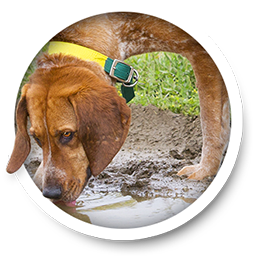
When I go out in the duck blinds, I love when all my ducks all lined up. It makes my job easier. Well, when your car is all lined up, it makes driving a pleasure. So today, we will bark about alignment and making sure your car is all lined up. So let's get barkin' and walk the line.
When you head down a straight road, does your vehicle pull to one side? Do you feel a vibration in any of the wheels? If you've noticed any of these things, it's probably time for you to get your wheel alignment checked.
When your vehicle left the factory, its wheels were parallel to each other and perpendicular to the ground. That maximizes traction for good steering and braking. Every time you take your vehicle on the road, normal wear and tear will affect your alignment. Hit a bump, a pothole or a curb, and all those little knocks will add up
Bad alignment not only can cause your steering wheel to pull unevenly, it can also wear your tires out a lot faster than they should. In fact, if you look at your tires and see one side of the tread is a lot smoother than the other, it could be another sign of bad alignment.
Since different problems can cause similar symptoms, the first thing our trained technician will do is test drive your vehicle. Then, they'll check the front end and steering linkage as well as look for tire wear. Then, the technician will put your vehicle on a lift and use computerized diagnostic equipment to measure alignment angles so they can precisely align your vehicle's components.
There are different kinds of alignments. One is a front-end alignment that aligns components of the vehicle's front axle. Another is a thrust alignment that makes sure the front wheels are lined up with the direction the rear wheels are pointed. A third type is four-wheel alignment which is usually used on all-wheel drive and 4-wheel drive vehicles. It's also recommended for front-wheel drive vehicles that have independent rear suspensions. It makes sure the angles of all the wheels are where they should be relative to each other and also the vehicle's body or frame.
Your steering wheel should be perfectly centered if you are heading straight down the road, so the technician will adjust it so it is. Finally, they'll take your vehicle back on the road for a final test drive to ensure it's performing the way engineers intended.
Your service adviser can recommend how often you should have your alignment inspection since it depends on the type of vehicle you drive (SUV, sporty car, etc.) and your driving environment. Properly aligned wheels can help your vehicle perform better and save you from expensive repairs down the road.
"An object in motion tends to remain in motion along a straight line unless acted upon by an outside force." ~ Isaac Newton
Cayenne

Allied Auto Works
2073 Grant Road
Los Altos, CA 94024
650.968.7227
https://www.alliedautoworks.com/